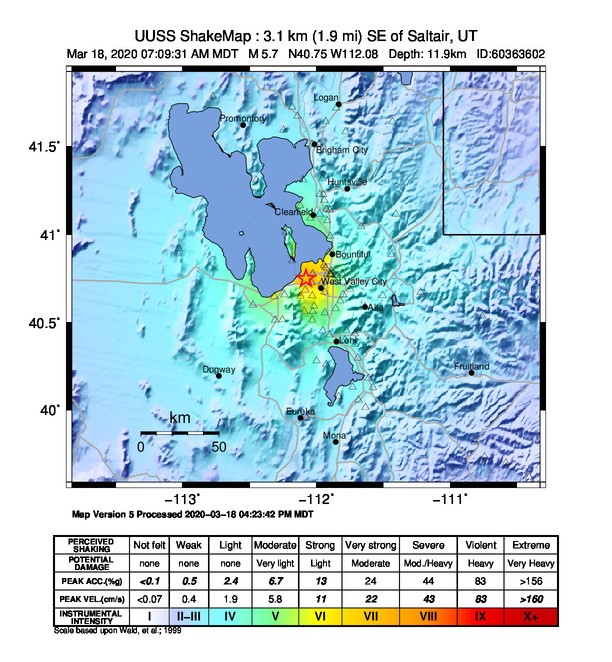When we hear of an earthquake occurring in the U.S. we immediately think of California, but other parts of the country are also at risk. We were reminded of this last week when an Mw 5.7 earthquake struck 15 km west of Salt Lake City, Utah, at 7:09 a.m. on March 18, 2020. The quake was followed by dozens of aftershocks, one of which was as large as Mw 4.6. This was the largest earthquake in Utah since the 1992 M5.9 earthquake in St. George (the USGS records this event in local magnitude only).

Impact
Damage from last week’s earthquake appears to have been relatively minor, and fortunately no serious injuries were reported. There were power outages and gas leaks, and a spill at a warehouse in Kennecott that released a cloud of hydrochloric acid. Flights were diverted while Salt Lake City International Airport briefly closed, the FrontRunner train service between Murray and Salt Lake City was halted for two hours because of damage to the line, and the TRAX train service was suspended into the evening. With the coronavirus pandemic ongoing, the state’s Department of Health laboratory was put out of commission for a day or so and the state's coronavirus hotline temporarily shut down.
Property damage is still being assessed. Most of the reported damage is minor and concerns items falling off walls or shelves, but in West Valley City 48 manufactured homes were shaken from their foundations. Buildings in the center of Salt Lake City, particularly unreinforced masonry structures, appear to have fared the worst; fallen masonry is widely reported. Most conspicuously, the gilded statue of the Angel Moroni atop the highest spire of the iconic Temple of The Church of Jesus Christ of Latter-Day Saints lost its golden trumpet and stones on some of the temple’s smaller spires have reportedly moved. The temple is partway through a four-year program of improvements that includes a seismic retrofit.
Seismic Hazard in Utah
The highest earthquake hazard in the continental United States is largely associated with California; across the Rocky Mountains in the Central and Eastern United States, the hazard drops significantly, but it does not disappear. The entire western half of the United States is full of seismic sources. There are, for example, the subduction and transform plate boundaries along the West Coast, the Yellowstone hotspot, and the extensional regime that is the basin and range province.
Salt Lake City sits at the border of the basin and range province in the Intermountain region, which consists of Nevada, Arizona, Utah, Montana, New Mexico, Colorado, and Wyoming. One of the major seismic zones in the Intermountain region is the Wasatch fault zone at the base of the Wasatch Mountains in Utah. The major cities of Ogden, Salt Lake City, and Provo, together home to about 75% of the state's population, are all located right on the edge of this fault, which can produce potentially catastrophic earthquakes larger than Mw 7.0 once every few centuries.
Since 1900 this region has been the site of 50 earthquakes with magnitudes between 5.5 and 7.5. The recent Mw 5.7 event was a moderate earthquake of a size that the state experiences about once a decade on average, but in a 2016 study the Working Group on Utah Earthquake Probabilities estimated that there was a 43% probability of the Wasatch Front experiencing an Mw 6.75 or greater earthquake in the next half century.
Read “Earthquake Risk in the United States: A Major Model Update“




